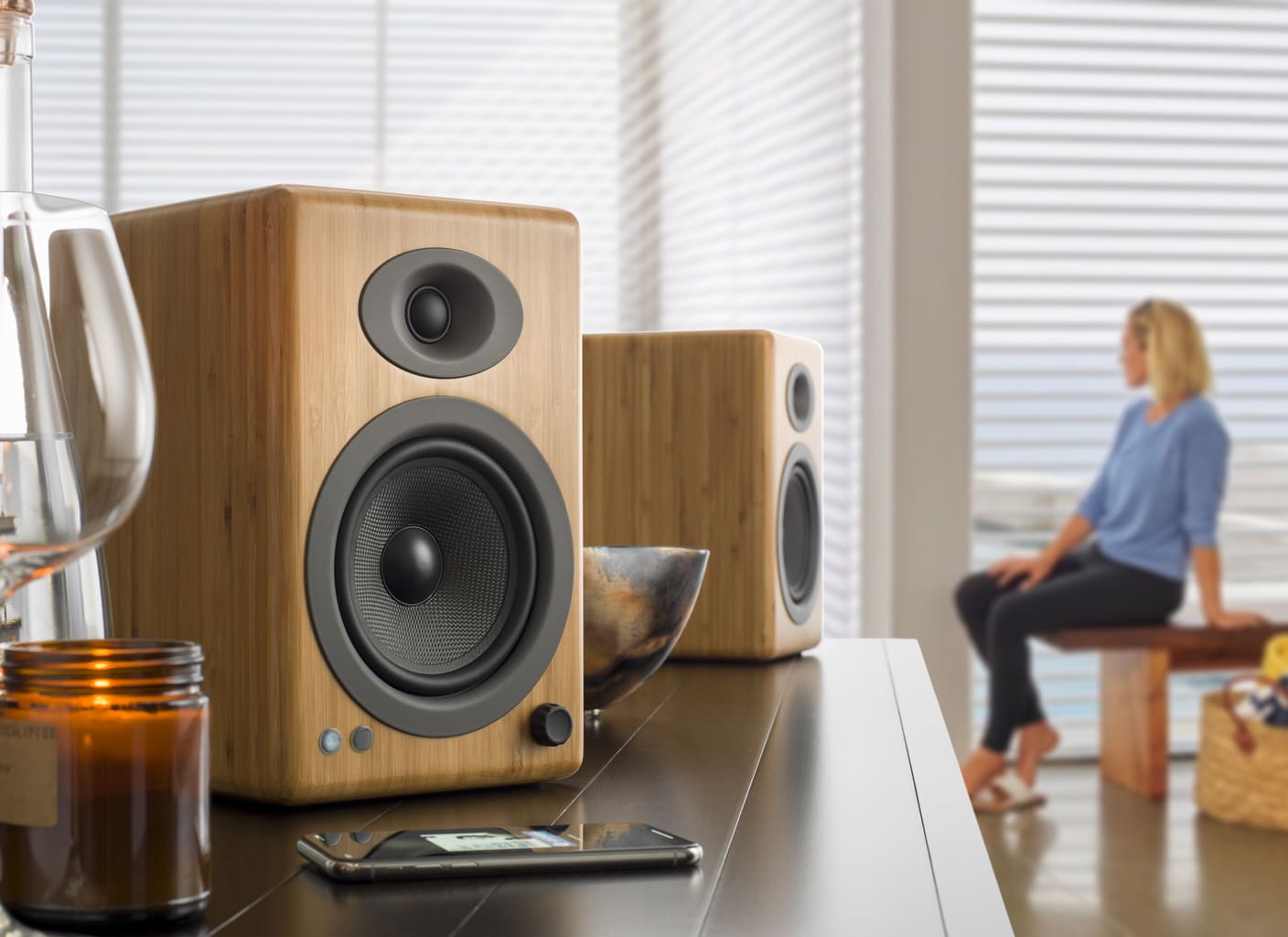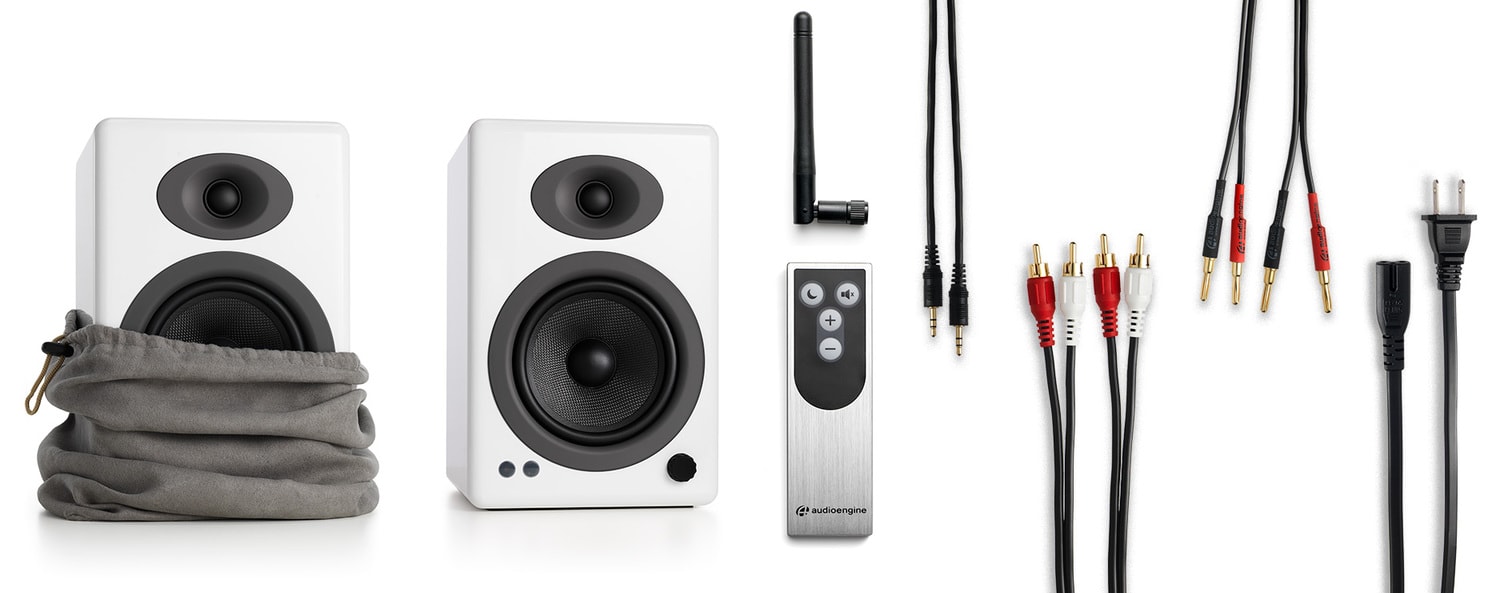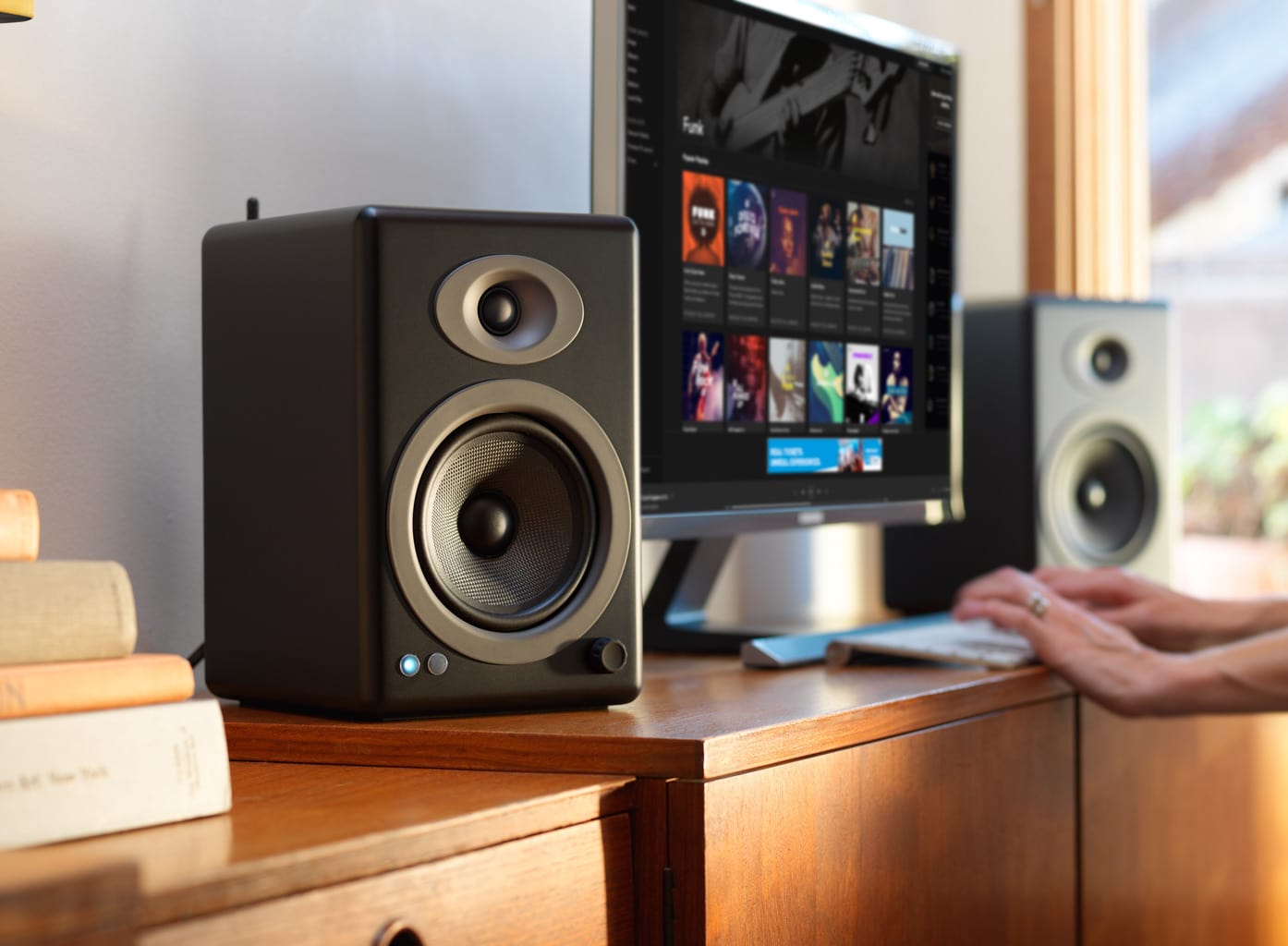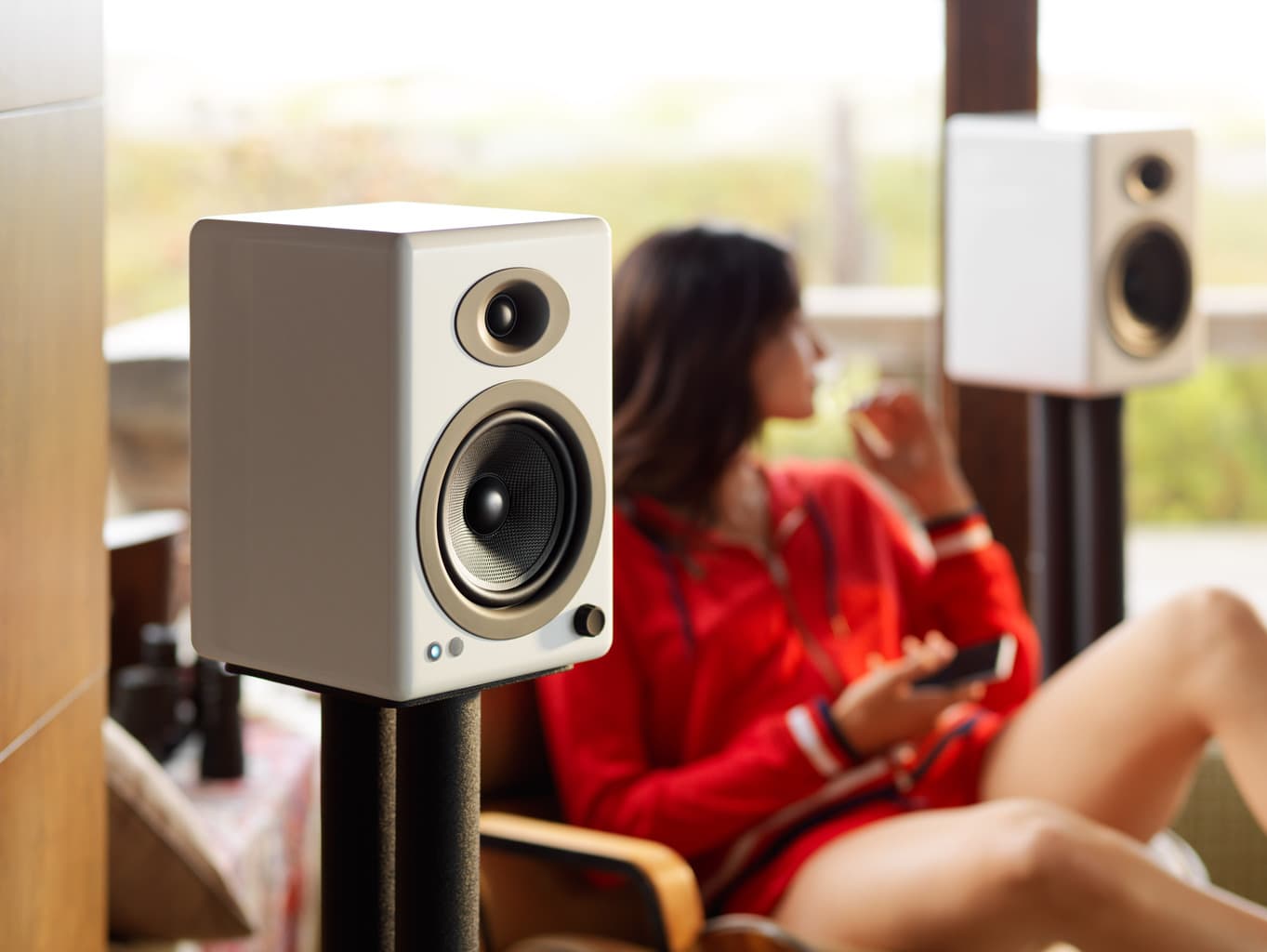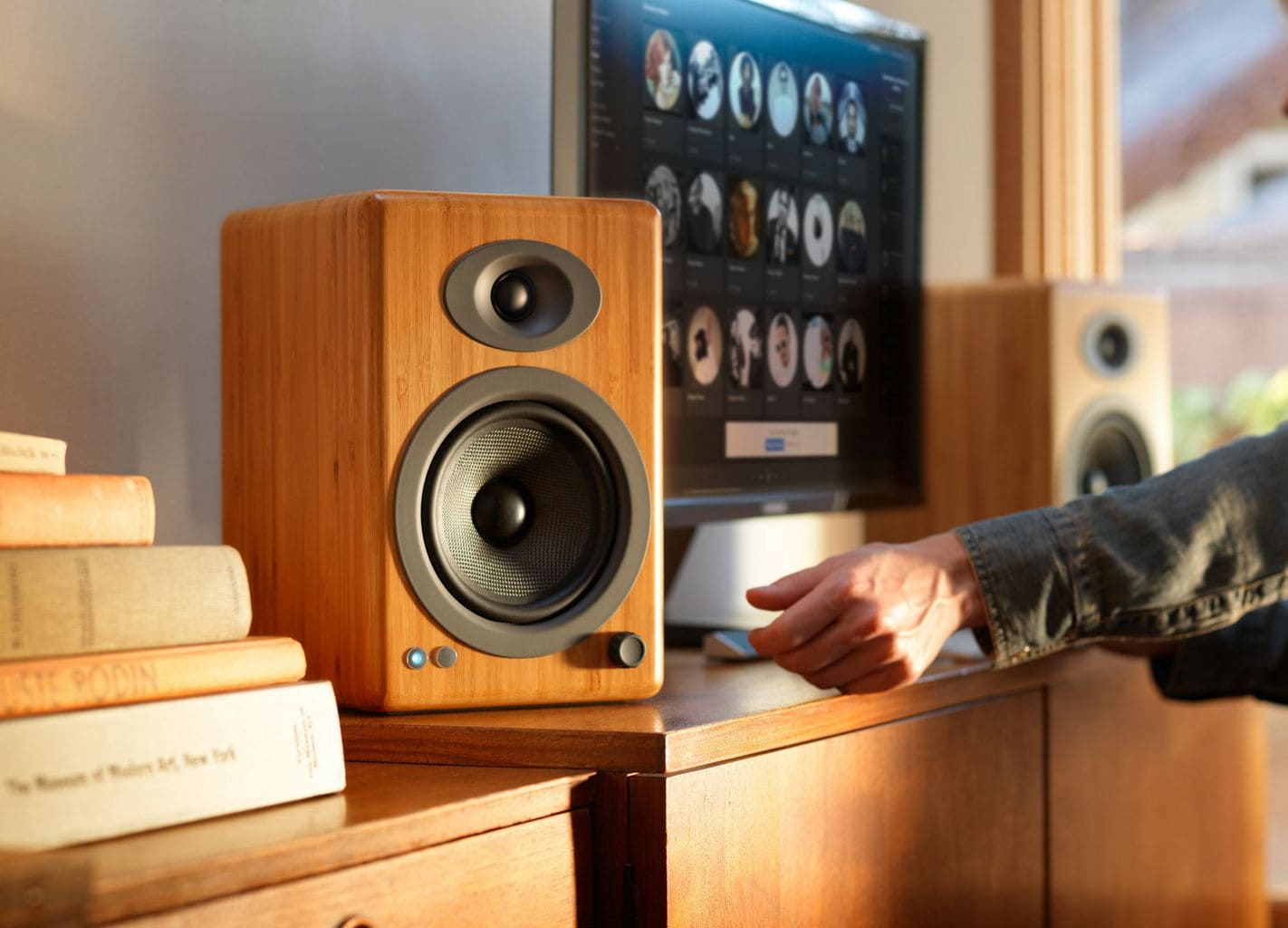I’ve been an admirer of Audioengine gear for some time,
since first being exposed to their Bluetooth B2 speaker a few years ago.
I’ve also had an Audioengine D3 headphone amp/DAC in my office rig for years. Their combination of price and performance makes them easy recommendations to friends and colleagues who ask me to suggest affordable, easy to use, decent sounding products. In that sphere, Audioengine delivers the goods.
The A5+ wireless speakers are a bit of a step up from the B2, coming in around the $500 mark in stock black or white, or $569 in a more eye-pleasing bamboo finish. For this price you get a pair of hefty, amplified speakers capable of running wirelessly or wired, complete with cables and an elegant remote control. Just add music – from your phone, tablet, laptop or any other line-level device. Connection is pretty obvious but the enclosed manual and online support are provided for those who need more information.
Each speaker cabinet is 10″ x 7″ x 7¾” (27 x 18 x 20 cm), with a 5” kevlar woofer and ¾” silk dome tweeter. The left speaker contains the electronics and the heatsinks for the class A/B amplification, which protrude a further 1 1/4″ out the back plus any additional space needed for cables – something to keep in mind when considering a desktop setup. The right speaker is entirely passive and sports only a pair of binding posts on the rear for the speaker cable input. The speakers are hefty and feel quite solid at 15.4 pounds (7 kg) and 9.6 pounds (4.4 kg) respectively.
At this price level you might be surprised to learn that Audioengine have used class A/B monoblock amps with gapless toroidal power transformers of their own specification. Mounted circuit boards inside ½” thick MDF cabinets and a narrow port that runs the width of the speaker near the top, smoothly finished, give an impression of quality that sets these above typical “desktop” monitors. Analog inputs are via 3.5 mm minijack and RCA, and there’s also a pair of line outputs for connection to other powered speakers or a subwoofer. The Bluetooth supports aptX HD, aptX, AAC and SBC codecs that feed an internal upsampling DAC.
Mine came in a matte black finish that together with the clean edges make them look better than my description above might suggest. Threaded inserts in the base can be used if you want to secure them to stands. There are no grill covers. Unpacked from the elegant sleeves Audioengine uses to wrap their products inside the box, I had the little A5+s lined up in my room and playing music within minutes.
What’s that big sound?
I don’t really consider myself much of a streaming or wireless listening chap but the Audioengine A5+ combo could be a game changer for me. I hit the pair button on the back and went into the study where my Macbook was situated. I opened bluetooth and there was the A5+ in the dropdown menu waiting to be selected. I hit it, opened iTunes and nearly leapt off of my seat as soon as I hit play. The sounds from the adjoining room were loud, incredibly loud, uncomfortably loud. Can that really be those little speakers I asked myself? Sure enough, loud they were but that’s not all. These little beasts were loud and in control.
Of course, with a volume control on the front of the powered speaker that turns multiple circles without any markings or reference points, you have to calibrate by ear. Obviously I’d fiddled with it and left it pretty wide open, but I soon learned to set it in a range that left final adjustments at the source end have enough flexibility to work in my range of comfort. Calming down, I continued to play tunes for an hour or so, moving the speakers around a little to make sure they were working well enough in the room. While I had not intended to leave them there, I was intrigued by the sonics sufficiently to allow the little A5+s to be my main source of listening for a month or so in my living room.
What I learned in that time is as follows. First, even though they can be placed just about anywhere, actual placement does matter. The A5+s can work on a table top or cabinet but sound best placed on stands and given room to breathe. Just plonking them down on a convenient surface risks choking the sonics. Sure, they work, and you might even enjoy the results, but you won’t hear them come alive and breathe unless you treat them like any other speaker whose qualities you want to maximize. That said, their ease of placement gave me a chance to try new speaker positions, satisfying my desire to test a long-wall layout without having to haul my main rig around. You could set them up outside pretty quickly too, provided you have a convenient power outlet and a surface to put them on.
Second, these deliver a solid, room-filling, dense sound that excels in the midrange. Before the A5+, I characterized the Audioengine sound as warm and leaning toward bass heavy, a bit of oddity given the size of their speakers. But the A5+ has upped the sound quality considerably. Whether it’s the inbuilt DAC in the Bluetooth connection or the drivers in a larger cabinet with matched amps (or more likely a combination of both), these speakers sound more neutral, more musical and at times almost airy in comparison to the B2.
For weeks I enjoyed using the A5+s in my main room. Being able to instantaneously call up newly ripped tracks from my hard drive without having to warm up amps or remember to turn things off when I left the house was completely liberating. For a few fun-filled weeks I picked out tracks from albums I’d not spun in years, from Prince to Puccini, and found myself smiling at the realization of how much great music I have that I need to dig out and give a fresh listen. And all this using only the Bluetooth connection, which operated flawlessly for me. I paired them with 2 laptops, an iPad and my iPhone, repeatedly, without a hitch. For straight-up usability, these speakers get a strong recommendation.
Of course, 10-inch tall box speakers are not going to sound as full and detailed as my reference Von Schweikert 5s, but then that’s hardly the competition. These Audioengines sound good enough to do all music justice, so you feel you are not giving up the pleasures of audiophile listening by totally compromising sonics for convenience. To use the cliché, they indeed sound bigger than they look and resolve details sufficiently to draw you into listening. More importantly, the A5+s proved a boon to late night listening sessions. When others in my household retire for the night, this late-bird usually turns off the regular rig because even at low volumes, it just sounds big. The A5+s, however, were perfect for enjoyable personal listening, especially with the remote control offering finer volume adjustments than my laptop. In the nearfield, I still had soundstage and resolution while those in nearby rooms could remain undisturbed. For this alone, the A5+s get my fullest appreciation.
From music room to desktop
From the living room they moved eventually into my study, where I got to try them in a desktop set up with both wired and wireless connections. For some folks these might seem too large for desktop monitors but I regularly use a pair of JBL Series 3s which are even larger so to my eyes they are fine. Placed on either end of my 5ft desk, on Sonic Wedge bases which aim them slightly up at my ears, I found the shift from the studio monitor sound of the JBLs noticeable, and not necessarily for the better. The JBLs are mainly for me to run my guitar into the speakers via an Audient ID4 interface rather than for music listening, but I do both in this room and I’ve come to understand the differences people report between studio and audiophile sonics. It took a while, but I found the set up and positioning that made the soundstage and tonality work, and proceeded to listen for hours to music here. For the record, I liked them pushed wide to the edges of my desk and angled in toward me, with my head about 26” from each speaker. This delivered a decent center image with enough height and depth to feel immersed in the music.
Now here I had a chance to compare the wired and Bluetooth modes, once I’d purchased a pair of cables that could interface with the Audient ID4. (The ID4 is a musician’s rather than audiophile’s product and uses ¼” output jacks instead of RCAs, so I needed to buy adapter cables from ¼” jacks to the A5+s RCA inputs.) I did initially try connecting the headphone output on my Macbook Pro to the 5+, but this did not sound as good as the Bluetooth so I gave up on that after a few tries.
The Audient has an inbuilt DAC which they don’t reveal much about in their specification sheet so it’s hard to know what is being compared to the Audioengine’s 24-bit AKM AK4396 DAC, but to my ears the ID4 is a good sounding component. Once wired up, and after what seemed a convoluted set of volume adjustments to get the levels comparable (Audient is not adjustable via the Audio Midi controls on the Mac), I was able to go back and forth with ease between both inputs while music was playing. While I suspect most people just assume the wired connection will always be superior to Bluetooth, I am not sure I could tell the difference reliably in a blind trial. In fact, so good is the A5+s Bluetooth connection that I think many folks would stop there and feel no need to consider adding an external DAC, except for higher resolution files, which I don’t own.
Over time I ended up using the Audient-wired connection, probably because I have the same biases as everyone else – and hell, I’d spent money on cables to test this thing – but if you changed the connections when I was not looking I doubt I could tell when listening to music while working. Going back and forth, listening very carefully to a couple of tracks in sighted A/B fashion, I think the wired connection resolved the bass more cleanly and had a generally improved sense of cohesion and body, but it’s close and requires so much effort to hear that I don’t think it really matters to me. Of course, if you have a fancy DAC you love on your desktop then that might make the differences more apparent but for most folks that Bluetooth connection from an appropriate source will likely sound great.
Further tweaks had to be tried. Although Audioengine report that the power cord they provide is perfectly suitable, audiophiles naturally want to know if there are improvements to be found here. Since the A5+s use a C7 connector, I also bought a Pangea IEC to C7 adapter and naturally enough, used it on a thick Pangea power cord, one of more than a few spares I have lying around (don’t ask). Having already decided that plugging everything into my API Power Wedge was beneficial in my study, it seemed easy to test if the cord mattered. To my ears there’s a slight improvement to be had over the stock cord, particularly in bass resolution, and if you have a spare cord, the cost of the Pangea adapter at less than $20 delivered is a tweak you can easily try. I liked what I heard enough to leave everything place, though I am open to the idea that I was just pleased to have found a use for the cord and rationalized accordingly.
Over a few weeks I grew to like the A5+ in my study. Long hours spent with them either streaming the local NPR station while working or running through long-forgotten albums from a hard drive proved illuminating. While not entirely losing Audioengine’s characteristically bass-heavy sound, in the nearfield this is not unpleasant or overwhelming. On spoken radio streams, the sound is light and detailed, with an intimacy that makes the announcers sound close but never boomy.
On music, for the most part, the sonics are similar: a detailed, resolving mid- and upper-range balance that might even strike some as bass-light on a few tracks, though I’d call it ‘bass-nimble’, particularly with the few tweaks I tried. Normally I listen to everything set flat on the built in iTunes equalizer but I’ll admit, the ability to adjust various frequencies can yield improved bass on a few recordings. Personally, this is more effort than I care to make most of the time so I just ended up setting it flat and listening away happily. There were still moments of lumpy bass on rock. Queen’s ‘You’re my best friend’ for their Greatest Hits came across with a sort of one-note bass that took some of the joy from the tune, and Manic Street Preachers ‘Life’s becoming a landslide’ from Gold Against the Soul seemed bit boomy, especially when cranked up. Is this an iTunes problem that would be improved with a better audio player? Maybe. Is it just a problem inherent in small desktop environments? Probably. Is it the Audioengine’s sonic signature? Hard to know for sure. Don’t let this little niggle be more than an observation about my room, desk and set up. To my ears, these A5+s are a sweet combo and clearly amenable to tweaking for the utmost sonic pleasure. And don’t forget, Audioengine offer a $350 subwoofer designed to partner these – I suspect that combination would resolve the bass question, so to speak.
Conclusion
I feel the A5+ wireless are more than desktop speakers. They actually sound better to my ears when used as regular speakers in a normal room. I suspect my ears are used to the JBL studio monitors for the type of listening I do at the desk, particularly when playing guitar. This is not to say the A5+s won’t sound great to your ears on a desktop and prove perfect for the task, I just think these speakers are capable of more than such duties. To that end, one really could envisage a pair of these serving as an almost one-stop audiophile rig, paired with whatever digital device you have. Throw in some stands and you could be rockin’ the joint and having personal late night sounds for comparative chump change in the audiophile universe. These are my new recommendation for anyone looking to spend $500 and have a decent sounding, configurable, well-built but portable set up that will enable upgrades to the wired front end with a better DAC or a vinyl setup should you wish. Enjoyable, usable, and affordable, it’s a very tempting combination.
Click here to read the article on HiFiZine.com.





